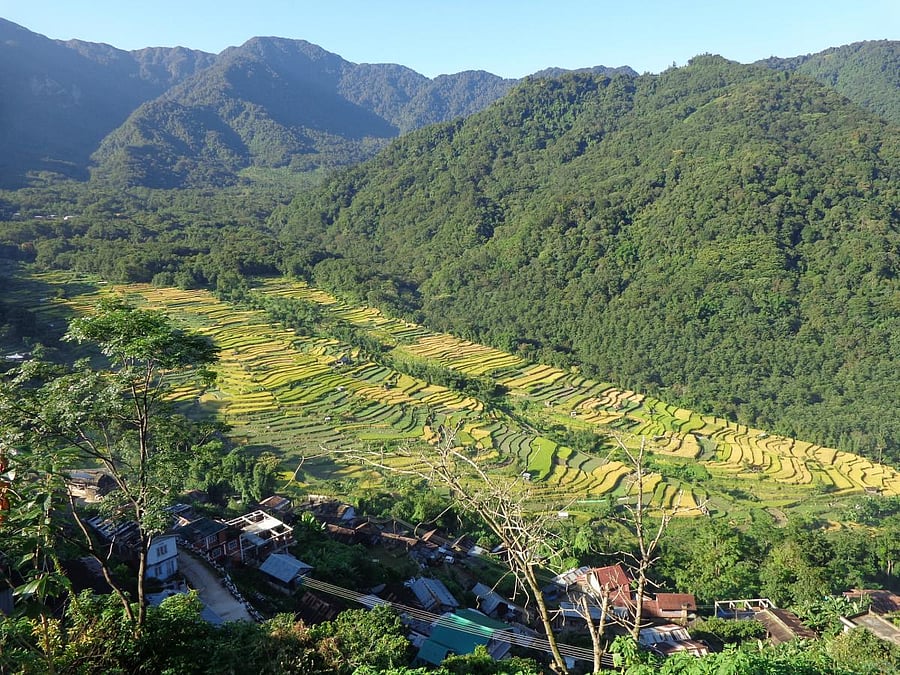

With distinctive dappled plumage on its back, bright red neck and yellow face, the Blyth’s Tragopan (Tragopan blythii), Nagaland’s state bird, is a rare sight to behold. In the early 1990s, nearly 300 of these birds were killed in Khonoma, Nagaland in a hunting competition — a custom that was common in the region. Once a hunting ground, the village now boasts of being a sanctuary for the birds.
What caused this change of heart?
The week-long hunting competition caused alarm in a few village elders. Along with select forest officials, the elders campaigned for a ban on hunting and logging and convinced other villagers to abandon these activities. This was not an easy task. The village council invited experts from conservation organisations to begin a dialogue with the residents of Khonoma and conduct educational workshops. Along with the forest department, the council spent more than eight years engaged in dialogue.
Their efforts culminated in a ban on hunting and logging in Khonoma’s forests in 1998. A 20 sq km area was even demarcated as the Khonoma Nature Conservation and Tragopan Sanctuary, making it the first community-led conservation project in India. Today, 120 sq km of wooded lands in Khonoma have been declared as a conservation reserve and protected area.
The area now not only boasts of a population of 300 Tragopan birds but has also become a safe place for other vulnerable species such as the clouded leopard and the Asiatic black bear.
Sustainable agriculture
The village, located 20 km from Kohima, the capital city of Nagaland is inhabited by about 3,400 people and is estimated to be 500 years old. Khonoma is primarily populated by the Angami Naga community and consists of three Khels (Big colony).
The Angami farmers practice a unique variant of Jhum cultivation. Jhum cultivation, which is common in Nagaland, causes soil erosion. However, this village practices a highly productive form of Jhum that utilises alder trees that grow in most parts of Nagaland.
Normally, Jhum cultivators fully cut and burn down trees. In Khonoma, the trees are not cut but pruned. The pruned wood yields material for both fuel and construction. Each Angami family grows a variety of crops along with the alder trees.
The trees are cut from the tip when they are about six feet tall, usually in December or February. Soil is placed on the tip in order to not let the tree wither. Save for one or two branches, all others are cut off. A few years later, the trees will re-emerge.
Since the Angamis practice shifting cultivation, the alder trees supplement the soil rich nutrients when the land is fallow (for four years).
“This indigenous method of pollarding alder trees can not be compared with modern methods and this is still in practice. This system is sustainable and is slowly finding its way into other regions,” says Ketho, son of the late Sherlie, an elder who started conservation efforts.
The department of agriculture in the government of Nagaland has studied this method in detail and proposed its adoption in other parts of the state.
Green village
At the bottom of Khanoma, wet paddy fields spread out like a green carpet, painting a serene picture. This scenic village became India’s first ‘green village’ in 2005. Its success in conservation, as well as sustainable agricultural practices, drew the attention of the Tourism Ministry, which gave it the tag.
According to Rovi, our guide, many states, including Meghalaya, have studied Khonoma’s efforts with an intention to emulate the initiatives.
The green village tag has garnered the interest of many tourists, scientists, nature lovers and students. Several households here earn an income by managing homestays, guiding tourists, providing transport and other tourism-related services.
Old forts, gates, monuments are maintained well in the village. Homes and community houses are still decorated with trophies, considered symbols of valour and skill.
The village is also considered one of the cleanest in Nagaland. “The credit goes to Khonoma Student’s Union,” says Kose, a resident of the village. The union installed dustbins in front of every house, gully and even on staircases. On roadsides, one can spot pots with flowers and vegetables. Young children volunteer to water these pots.
Khonoma has become a model for interdependence with nature. After 25 years, the spirit of conservation remains strong and is spreading to other areas as well.